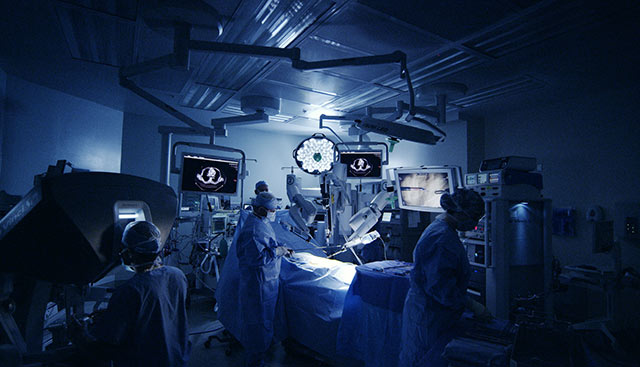
Collaboration on New Developments for Robotic Lung Surgery Computer Interface
The benefits of robotic lung surgery include smaller scars, less pain, faster recovery, less bleeding and less possibility of requiring a blood transfusion. When performed by experienced surgeons, robotic lung surgery is safer than traditional open surgery with less chance of developing complications such as pneumonia. For the surgeon, robotic surgery provides advantages not offered through traditional surgery, including the use of small incisions, 3D vision, magnified vision, dexterous instruments and a scale of motion that allows more precise movements while performing surgery.
“The future of robotic lung surgery is tied to new developments in the computer interface,” said Dr. Jacques Fontaine, thoracic surgeon at Moffitt Cancer Center.
An enhanced computer interface between the patient and the surgeon is expected to further advance the benefits of robotic surgery for patients with lung cancer and will present key differences between robotic surgery and minimally invasive video-assisted thoracoscopic surgery, said Fontaine.
Beyond these benefits, the multifaceted computer interface will offer an enhanced surgery experience in several ways:
- If dye is injected into the blood vessels, the computer interface will allow the surgeon to see where there is good blood supply in the lungs, as well as where the blood supply is less optimal
- Similarly, if dye is injected into the lymph nodes, the surgeon can see where the lymph nodes are more likely to have cancer and to locate the lymph nodes less likely to have disease
- The surgeon can view the patient’s lung with a superimposed CT scan of the lung nodule live in real time and be able to precisely view where the nodule is during the robotic procedure
Fontaine and Moffitt thoracic surgeon Dr. Eric Toloza are collaborating with researchers and engineers who are developing the computer interface enhancements for the da Vinci robotic surgical system. The new features of this computer interface are expected to be available commercially within the next two to three years.
Fontaine and Toloza have been invited to share their feedback as surgeons to assist in development of the next generation robotic system. They perform on average six to eight robotic lung surgeries per week and have performed well over 2,000 robotic lung surgeries at Moffitt since 2010.
They also mentor other surgeons from throughout the United States who want to learn the technical specifics of thoracic robotic surgery. Through this program, surgeons receive didactic teaching, participate in preclinical labs and observe live robotic lung surgeries performed at Moffitt. “Then we go to their local hospital wherever they are in the country and we proctor them, or coach them, as they do their first cases. It’s a complete mentorship program, and we have done this for several dozen surgeons,” said Fontaine.
In another initiative to further the practice of robotic lung surgery, Fontaine directs Moffitt’s Robotic Thoracic Surgery Fellowship. Each year through this fellowship, started in 2015, a newly graduated, board eligible thoracic surgeon who wants to learn robotic lung surgery before going into practice comes to Moffitt for 12 months of intensive training. “Robotic surgery is undeniably the future of surgery, so every hospital wants their surgeons to be able to perform robotic surgery, but not every teaching institution is providing this training. Because of our experience here, we decided to create the teaching program,” said Fontaine.
Although robotic surgery systems represent the latest technology and advancements and the computer interface developments will add even more benefit, Fontaine cautioned patients not to seek care at a hospital simply because it has a robotic system.
“Most hospitals today have robots. The robot for surgery is an expensive, technologically advanced tool, but it is still just that — a tool,” said Fontaine. “It is not enough for a patient to simply see a physician who can do robotic surgery. A patient with lung cancer needs to see somebody who not only has expertise in robotic surgery but who also is experienced in treating patients with lung cancer. Such a physician can provide a valid recommendation of the best treatment plan for each patient, whether robotic or traditional surgery or whether nonsurgical treatment such as radiation therapy or immunotherapy would offer a better treatment choice.”
For patients considering robotic lung surgery, it is important to go to a facility where many such procedures are performed. The more robotic experience a surgeon has, the better the outcomes. “According to data from Intuitive, which manufactures the da Vinci robotic system, Moffitt is performing more robotic lung surgery procedures than any other single center in the Southeast United States,” said Fontaine.
To refer a patient to Moffitt, complete our online form or contact a physician liaison for assistance or support. As part of our efforts to shorten referral times as much as possible, online referrals are typically responded to within 24 - 48 hours.
